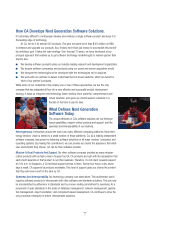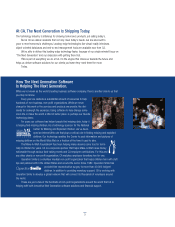Computer Associates 1997 Annual Report Download - page 18
Download and view the complete annual report
Please find page 18 of the 1997 Computer Associates annual report below. You can navigate through the pages in the report by either clicking on the pages listed below, or by using the keyword search tool below to find specific information within the annual report.
The Company’s products are designed to improve
the productivity and efficiency of its clients’ data processing
resources. Accordingly, in a recessionary environment, the
Company’s products are often a reasonable economic alternative
to customers faced with the prospect of incurring expenditures to
increase their existing data processing resources. However, a
general or global slowdown in the world economy could adversely
affect the Company’s operations.
The Company has historically reported lower profit mar-
gins for the first two quarters of each fiscal year than those expe-
rienced in the third and fourth quarters. As part of the annual
budget process, management establishes higher discretionary
expense levels in relation to revenue for the first half of the year.
Historically, the Company’s combined third and fourth quarter
revenue have been greater than the first half of the year, as these
two quarters coincide with clients’ calendar year budget periods
and the culmination of the Company’s annual sales plan. These
historically higher second half revenue have resulted in signifi-
cantly higher profit margins since total expenses have not
increased in proportion to revenue. However, past financial perfor-
mance should not be considered to be a reliable indicator of
future performance.
The Company’s future operating results may be affected
by a number of factors, including, but not limited to: uncertainties
relative to global economic conditions; market acceptance of com-
peting technologies; the availability and cost of new solutions; its
ability to successfully maintain or increase market share in core
businesses while expanding its product base into other markets;
the strength of its distribution channels; its ability to effectively
manage fixed and variable expense growth relative to revenue
growth; and its ability to effectively integrate acquired products
and operations.
There have been no special marketing programs by the
Company which have had a material effect on the revenue or net
income of any given quarterly period.
Foreign Currency Exchange
Uncertainty in world economies and the expectations for higher
U.S. interest rates caused a gradual strengthening of the U.S.
Dollar during fiscal year 1997. Approximately 40% of the
Company’s total revenue in fiscal year 1997, 50% in fiscal year
1996 and 49% in fiscal year 1995, was derived from sales out-
side of North America. The net income effect of foreign currency
exchange rate fluctuations versus the U.S. Dollar on international
revenue is largely offset to the extent expenses of the Company’s
international operations are incurred and paid for in the same
currencies as those of its revenue. During fiscal 1997, the net
income effect of foreign exchange losses was approximately $7
million. A foreign currency translation adjustment of $74 million
was charged to Stockholders’ Equity in fiscal year 1997. As part
of its risk management strategy, the Company did not enter into
any foreign exchange derivative transactions during fiscal years
1997 and 1996.
Selected Unaudited Quarterly Information
(in millions, except per share amounts)
1997 Quarterly Results June 30 Sept. 30 Dec. 31(1) Mar. 31 Total(1)
Revenue $792 $ 990 $1,053 $1,205 $4,040
Percent of total revenue 20% 24% 26% 30% 100%
Net income (loss) 120 223 (313) 336 366
– Per common share (3) $ .32 $ .59 $ (.86) $ .90 $ .97
1996 Quarterly Results June 30 Sept. 30(2) Dec. 31 Mar. 31 Total(1)
Revenue $578 $ 812 $1,004 $1,111 $3,505
Percent of total revenue 16% 23% 29% 32% 100%
Net income (loss) 89 (637) 227 265 (56)
– Per common share (3) $ .23 $(1.76) $ .60 $ .70 $ (.16)
(1) Includes an after-tax write-off of $598 million related to the acquisition of Cheyenne Software, Inc. in November 1996. See Note 2 of Notes to Consolidated Financial Statements for additional information.
(2) Includes an after-tax write-off of $808 million related to the acquisition of Legent Corporation in August 1995. See Note 2 of Notes to Consolidated Financial Statements for additional information.
(3) Adjusted to reflect three-for-two stock splits effective August 21, 1995 and June 19, 1996.
16
























